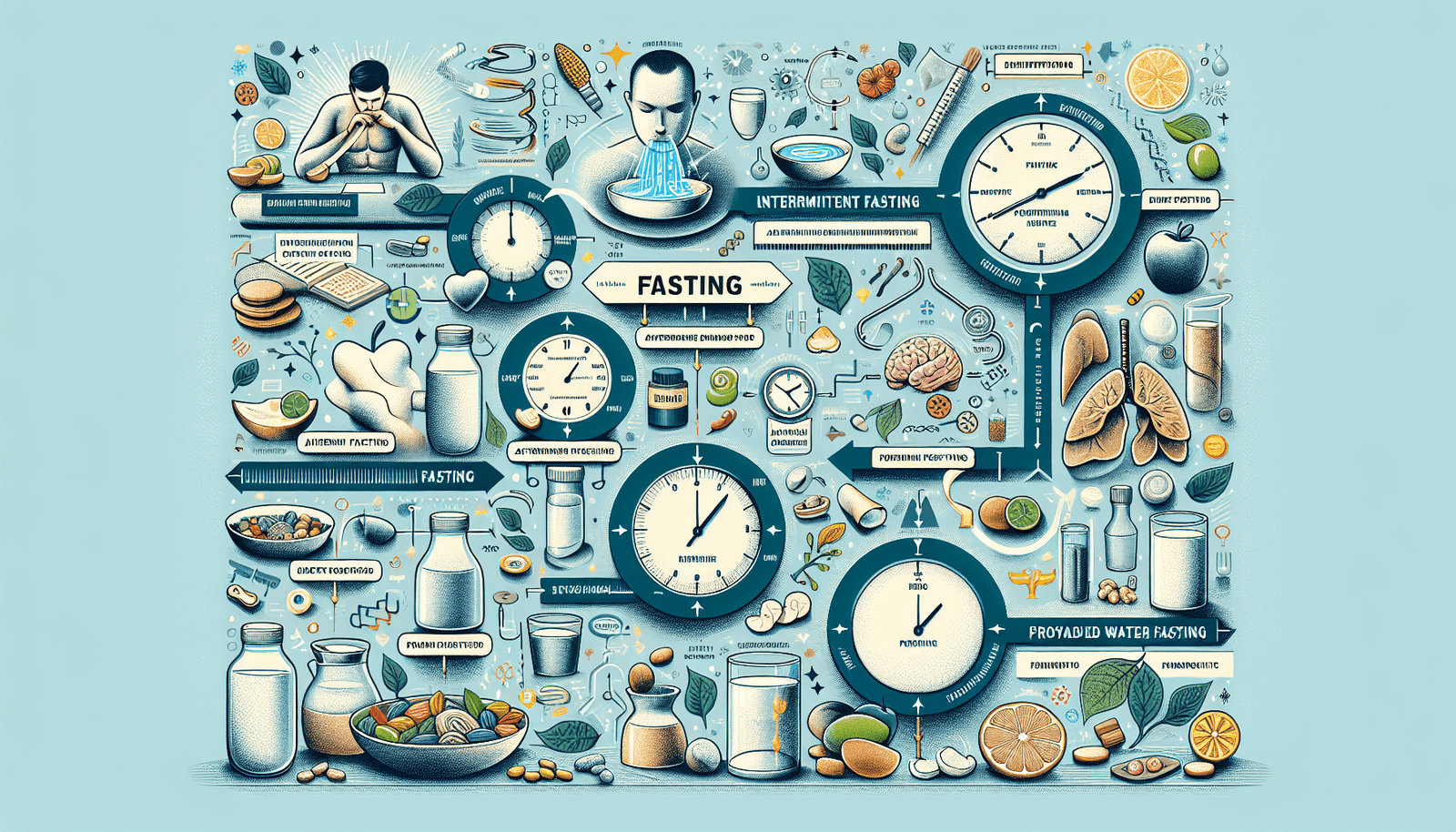Are you curious about the different fasting protocols that are gaining popularity among health enthusiasts? Look no further! In this article, you’ll discover a concise overview of the most popular extended fasting protocols that have been proven effective in promoting weight loss, improving mental clarity, and boosting overall health. From the renowned 16/8 intermittent fasting to the more challenging 5:2 method, you’ll find a fasting protocol that suits your lifestyle and goals. So, grab a cup of tea and let’s explore the fascinating world of extended fasting!

Water Fasting
Overview of Water Fasting
Water fasting is a type of fasting that involves abstaining from food and consuming only water for a certain period of time. It is often viewed as an extreme form of fasting and should be approached with caution. Water fasting allows your body to enter a state of ketosis, where it burns stored fat for energy instead of relying on glucose from food. This can lead to rapid weight loss and other potential health benefits.
Benefits of Water Fasting
Water fasting has been associated with various potential benefits. One of the main advantages is weight loss. By restricting your calorie intake to zero, your body is forced to utilize its fat stores for energy, resulting in significant weight loss over a short period of time. Water fasting has also been shown to improve insulin sensitivity, lower blood pressure, and reduce inflammation. Additionally, some individuals have reported increased mental clarity and improved digestive function during water fasting.
Challenges and Precautions
It is important to note that water fasting is an intense fasting method and should be approached with caution. Extended periods of water fasting can lead to nutritional deficiencies, muscle loss, and electrolyte imbalances. It is advisable to consult with a healthcare professional before embarking on a water fast, particularly if you have any pre-existing medical conditions. Additionally, pregnant or breastfeeding women, as well as individuals with a history of disordered eating, should avoid water fasting.
How to Do Water Fasting
To start a water fast, you should gradually reduce your calorie intake for a few days prior to the fast. This helps prepare your body for the period of fasting. During the fast, you should only consume water. It is crucial to drink enough water to stay hydrated and to help flush out toxins from your body. The duration of a water fast can vary, but it is recommended to start with shorter fasts, such as 24 hours, and gradually increase the duration as your body becomes accustomed to the fasting process. Breaking the fast should be done gradually and with easily digestible foods.
Tips for a Successful Water Fast
- Start with shorter fasts and gradually increase the duration.
- Stay hydrated by drinking plenty of water throughout the fast.
- Listen to your body and rest when needed.
- Keep yourself occupied and distracted to avoid focusing on food.
- Break the fast gradually and introduce easily digestible foods.
Intermittent Fasting
Overview of Intermittent Fasting
Intermittent fasting is a popular fasting method that involves cycling between periods of eating and fasting. There are different types of intermittent fasting protocols, but they all share the common goal of restricting your eating window. Intermittent fasting can be a more sustainable approach compared to prolonged water fasting, as it allows for regular eating periods while still providing potential health benefits.
Types of Intermittent Fasting Protocols
There are several different types of intermittent fasting protocols, including the 16/8 method, the 5:2 diet, and the alternate day fasting method. The 16/8 method involves fasting for 16 hours and restricting your eating window to 8 hours each day. The 5:2 diet involves eating normally for five days of the week and restricting your calorie intake to 500-600 calories for the remaining two days. Alternate day fasting, as the name suggests, involves alternating between days of normal eating and days of fasting.
Benefits of Intermittent Fasting
Intermittent fasting has gained popularity due to its potential benefits. One of the main advantages is weight loss. By limiting your eating window, your body has a shorter period of time to consume calories, resulting in a calorie deficit. This can lead to weight loss over time. Intermittent fasting has also been shown to improve insulin sensitivity, reduce inflammation, and support cellular repair processes in the body.
Challenges and Precautions
While intermittent fasting can be a flexible and effective approach to fasting, it may not be suitable for everyone. Some individuals may experience increased hunger and cravings during the fasting periods, which can make it challenging to adhere to the fasting protocol. It is important to listen to your body and ensure that you are still consuming enough nutrients and calories during the eating periods. If you have any underlying medical conditions or are taking medication, it is advisable to consult with a healthcare professional before starting intermittent fasting.
How to Start Intermittent Fasting
To start intermittent fasting, choose a fasting protocol that suits your lifestyle and goals. Gradually introduce fasting periods into your routine. For example, if you choose the 16/8 method, start by fasting for 12 hours and gradually increase the fasting window until you reach 16 hours. It can also be helpful to plan your meals and snacks during the eating periods to ensure that you are still meeting your nutritional needs. Monitor your body’s response to intermittent fasting and make adjustments as needed.
Tips for Effective Intermittent Fasting
- Start with a fasting protocol that you find manageable and gradually increase the fasting window.
- Stay hydrated during fasting periods.
- Plan your meals and snacks during the eating periods to ensure adequate nutrition.
- Listen to your body and adjust the fasting protocol as needed.
- Be consistent with your fasting routine to maintain its benefits.
Alternate Day Fasting
Overview of Alternate Day Fasting
Alternate day fasting is a fasting method that involves alternating between days of normal eating and days of fasting. It is a more structured approach compared to intermittent fasting, as it requires a full day of fasting every other day. Alternate day fasting can provide a balance between periods of food restriction and regular eating, with the potential for weight loss and other health benefits.
Methods of Alternate Day Fasting
There are different methods of alternate day fasting, each with its own variations. One common method is the 24-hour fasting method, where you fast from dinner to dinner, skipping breakfast and lunch the next day. Another method is the modified alternate day fasting, which allows for a limited calorie intake (around 500 calories) on fasting days. This can make the fasting days more manageable for some individuals.
Benefits of Alternate Day Fasting
Alternate day fasting has been associated with various potential benefits. It can aid in weight loss by creating a calorie deficit on fasting days. The intermittent fasting periods can also lead to improvements in insulin sensitivity and blood lipid levels. Alternate day fasting has the potential to promote autophagy, a cellular repair process, and increase lifespan in some animal studies. Additionally, it may have positive effects on heart health and inflammation markers.
Challenges and Precautions
Alternate day fasting can be more challenging compared to other fasting methods, as it involves a full day of fasting every other day. Some individuals may find it difficult to adhere to the fasting schedule or may experience increased hunger on fasting days. It is important to ensure that you are still meeting your nutritional needs, even on eating days, to avoid nutrient deficiencies. It is advisable to consult with a healthcare professional before starting alternate day fasting, especially if you have any underlying medical conditions.
How to Implement Alternate Day Fasting
To implement alternate day fasting, choose the fasting method that suits your lifestyle and goals. If you choose the 24-hour fasting method, plan your meals accordingly to ensure that you fast for a full 24 hours. On fasting days, stay hydrated with water and other calorie-free beverages. On eating days, focus on consuming nutrient-dense foods to meet your nutritional needs. Monitor your body’s response to alternate day fasting and make adjustments as needed.
Tips for Success with Alternate Day Fasting
- Choose the fasting method that suits your lifestyle and goals.
- Stay hydrated with water and calorie-free beverages on fasting days.
- Plan your meals on eating days to ensure adequate nutrition.
- Listen to your body and adjust the fasting protocol if needed.
- Be consistent with your fasting routine for optimal results.
Extended Time-Restricted Feeding
Overview of Extended Time-Restricted Feeding
Extended time-restricted feeding is a fasting method that involves extending the daily fasting period beyond the typical 16/8 intermittent fasting window. Instead of an 8-hour eating window, extended time-restricted feeding allows for a shorter eating window, such as 4-6 hours, or even just one meal a day.
Benefits of Extended Time-Restricted Feeding
Extended time-restricted feeding offers similar benefits to other fasting methods, such as weight loss and improved insulin sensitivity. By shortening the eating window, extended time-restricted feeding can create a more significant calorie deficit and potentially enhance fat burning. It can also support better digestion and nutrient absorption, as the body has more time to focus on these processes. Some individuals may find extended time-restricted feeding more sustainable and easier to follow than other fasting methods.
Challenges and Precautions
Extended time-restricted feeding may not be suitable for everyone, particularly those with specific dietary requirements or medical conditions. It is important to ensure that you are still meeting your nutritional needs within the shorter eating window. If you have any underlying health concerns or take medication, consult with a healthcare professional before starting extended time-restricted feeding. Additionally, it is crucial to listen to your body’s hunger and fullness cues during the eating window to avoid overeating.
Different Time-Restricted Feeding Protocols
There are different ways to incorporate extended time-restricted feeding into your routine. You can choose an eating window that suits your preferences and lifestyle. Some individuals opt for a 4-6 hour eating window, allowing for two or three meals within that time. Others may choose to practice one meal a day (OMAD), where they consume all their daily calories in one meal. Experiment with different time-restricted feeding protocols to find what works best for you.
How to Incorporate Extended Time-Restricted Feeding
To incorporate extended time-restricted feeding, determine the eating window that you want to follow. Gradually decrease the length of your eating window over time as your body adjusts to the fasting periods. Plan your meals within the designated eating window and ensure that you are consuming enough nutrients and calories during that time. Experiment with different food choices, portion sizes, and meal timings to find a routine that works for you.
Tips for Effective Extended Time-Restricted Feeding
- Choose the eating window that aligns with your preferences and lifestyle.
- Gradually decrease the length of the eating window over time.
- Plan and prepare your meals within the designated eating window.
- Focus on nutrient-dense foods to meet your nutritional needs.
- Listen to your body’s hunger and fullness cues during the eating window.
One Meal a Day (OMAD)
Overview of One Meal a Day
One Meal a Day (OMAD) is a fasting method in which you consume all your daily calories within a one-hour eating window and fast for the remaining 23 hours of the day. It is a more extreme form of time-restricted feeding and requires careful planning to ensure adequate nutrition.
Benefits of OMAD
OMAD can facilitate weight loss by creating a substantial calorie deficit, particularly if you consume nutrient-dense, low-calorie foods during the meal. It simplifies meal planning and can save time and money on food preparation. OMAD may also improve insulin sensitivity and promote autophagy, which allows for cellular repair and regeneration.
Challenges and Precautions
OMAD can be challenging due to the prolonged fasting period and limited eating window. It requires careful consideration of nutrient intake within a restricted timeframe and may not be suitable for individuals with certain medical conditions or dietary needs. Consulting with a healthcare professional before starting OMAD is advised, particularly if you have any underlying health concerns or take medication.
How to Practice OMAD
To practice OMAD, choose a consistent one-hour eating window that fits your schedule. Plan a nutrient-dense meal that contains all the necessary macronutrients and micronutrients. Include a variety of whole foods to ensure a balanced intake of vitamins, minerals, and other essential nutrients. It can be helpful to divide your meal into smaller portions and eat slowly to aid digestion.
Tips for Success with OMAD
- Start with a shorter eating window and gradually increase to one hour.
- Prioritize nutrient-dense foods to meet your nutritional needs.
- Plan your meal in advance to ensure a balanced intake of macronutrients and micronutrients.
- Consider incorporating intermittent fasting or extended time-restricted feeding before transitioning to OMAD.
- Listen to your body and adjust your eating window or food choices if needed.
The 5:2 Diet
Overview of The 5:2 Diet
The 5:2 diet is an intermittent fasting approach that involves eating normally for five days of the week and restricting calorie intake to 500-600 calories on the remaining two days. It is a flexible fasting protocol that allows for regular eating most of the week while still providing the potential benefits of fasting.
How The 5:2 Diet Works
The 5:2 diet works by creating a calorie deficit on the two fasting days, which can lead to weight loss. By consuming only 500-600 calories on these days, you are restricting your overall calorie intake for the week. It is important to note that during the fasting days, the focus should be on nutrient-dense foods to ensure you are still meeting your nutritional needs.
Benefits of The 5:2 Diet
The 5:2 diet has been associated with weight loss and improved insulin sensitivity. It may also have positive effects on blood lipid levels and inflammation markers. The flexibility of the diet allows for normal eating most of the time, which can make it more sustainable for long-term adherence.
Challenges and Precautions
The 5:2 diet may pose challenges for individuals who struggle with restricting calorie intake or experience increased hunger on fasting days. It is important to consume nutrient-dense foods on fasting days to ensure adequate nutrition while still staying within the calorie limits. If you have any underlying health conditions or take medication, consult with a healthcare professional before starting the 5:2 diet.
How to Follow The 5:2 Diet
To follow the 5:2 diet, designate two non-consecutive days of the week as fasting days. Limit your calorie intake to 500-600 calories on these days. On the remaining five days, eat a balanced, healthy diet without any specific restrictions. Focus on nutrient-dense foods, regular physical activity, and adequate hydration throughout the week.
Tips for Effective Implementation of The 5:2 Diet
- Plan your fasting days in advance and choose days that align with your schedule and preferences.
- Monitor your calorie intake on fasting days to ensure you stay within the recommended caloric limit.
- Focus on nutrient-dense foods to meet your nutritional needs on both fasting and non-fasting days.
- Stay consistent with your eating pattern and avoid compensating for fasting days by overeating on non-fasting days.
- Listen to your body and make adjustments to the fasting protocol as needed.
24-Hour Fasting
Overview of 24-Hour Fasting
24-hour fasting involves abstaining from food for a full 24-hour period. It is a type of intermittent fasting that can be practiced once or twice a week, depending on individual preference and goals. During the fasting period, only calorie-free beverages such as water, black coffee, or herbal tea are consumed.
Benefits of 24-Hour Fasting
24-hour fasting can promote weight loss by creating a calorie deficit for the day. It also allows the body to enter a state of ketosis, where it burns stored fat for energy. This can lead to increased fat burning and improved metabolic health. 24-hour fasting has also been shown to enhance autophagy, a cellular repair process, and support healthy aging.
Challenges and Precautions
A full 24-hour fasting period may be challenging for individuals who are not accustomed to longer fasting durations. It is crucial to stay hydrated during the fasting period and ensure that you are meeting your nutritional needs on non-fasting days. If you have any underlying health conditions or take medication, consult with a healthcare professional before starting 24-hour fasting.
How to Do a 24-Hour Fast
To do a 24-hour fast, choose a day that fits your schedule and start fasting after dinner on the previous day. Refrain from consuming any calories for a full 24-hour period, and break the fast with a balanced meal the following day. Stay hydrated with water, black coffee, or herbal tea throughout the fasting period.
Tips for Successful 24-Hour Fasting
- Plan your fasting day in advance and choose a day that suits your schedule.
- Stay hydrated with calorie-free beverages throughout the fasting period.
- Engage in light physical activity or relaxation techniques to distract from hunger.
- Break the fast with a balanced meal that includes protein, carbohydrates, and healthy fats.
- Listen to your body and adjust the fasting duration or frequency as needed.
36-Hour Fasting
Overview of 36-Hour Fasting
36-hour fasting involves abstaining from food for a full 36-hour period. It is a more extended fasting approach compared to 24-hour fasting and requires careful consideration of nutritional intake and hydration to ensure safe and effective fasting.
Benefits of 36-Hour Fasting
36-hour fasting can provide similar benefits to shorter fasting durations, such as weight loss, improved insulin sensitivity, and enhanced cellular repair processes. The longer fasting window allows for a more significant calorie deficit and can potentially enhance fat burning and autophagy.
Challenges and Precautions
Extended fasting periods, such as 36 hours, may pose challenges for individuals who are new to fasting or have specific dietary requirements. It is crucial to stay well-hydrated throughout the fasting period and ensure that you are still meeting your nutritional needs on non-fasting days. If you have any underlying health concerns or are taking medication, consult with a healthcare professional before attempting 36-hour fasting.
How to Practice 36-Hour Fast
To practice 36-hour fasting, choose a day that fits your schedule and start the fast after dinner on the previous day. Abstain from consuming any calories for the next 36 hours, and break the fast with a balanced meal at the designated time. Stay hydrated with water, black coffee, or herbal tea during the fasting period.
Tips for a Successful 36-Hour Fast
- Choose a fasting day that aligns with your schedule and preferences.
- Stay well-hydrated with calorie-free beverages throughout the fasting period.
- Listen to your body and rest if needed.
- Plan and prepare a nutritious meal to break the fast.
- Gradually introduce longer fasting periods and monitor your body’s response.
48-Hour Fasting
Overview of 48-Hour Fasting
48-hour fasting involves abstaining from food for a full 48-hour period. It is a more prolonged fasting method that requires careful consideration of nutritional intake, hydration, and overall health to ensure safety and effectiveness.
Benefits of 48-Hour Fasting
48-hour fasting offers similar benefits to shorter fasting durations, including weight loss, improved insulin sensitivity, and enhanced autophagy. The extended fasting window can result in a more significant calorie deficit and potentially lead to increased fat burning and cellular repair.
Challenges and Precautions
Fasting for 48 hours can be challenging, both mentally and physically. It requires careful planning, hydration, and consideration of individual health status. It is essential to stay well-hydrated throughout the fasting period and ensure that you are still meeting your nutritional needs on non-fasting days. Consulting with a healthcare professional is recommended before attempting 48-hour fasting, especially if you have any underlying health concerns or take medication.
How to Fast for 48 Hours
To fast for 48 hours, choose a day that allows for uninterrupted fasting and start the fast after dinner on the previous day. Abstain from consuming any calories for the next 48 hours, and break the fast with a balanced meal at the designated time. Hydrate with water, black coffee, or herbal tea throughout the fasting period.
Tips for a Successful 48-Hour Fast
- Choose a fasting day that aligns with your schedule and preferences.
- Stay well-hydrated with calorie-free beverages throughout the fasting period.
- Engage in light physical activity or relaxation techniques to distract from hunger.
- Plan and prepare a nutritious meal to break the fast.
- Gradually introduce longer fasting periods and monitor your body’s response.
Extended Fasting with Medical Supervision
Overview of Extended Fasting with Medical Supervision
Extended fasting with medical supervision involves undergoing a prolonged fasting period under the guidance and monitoring of a healthcare professional. This allows for a more comprehensive evaluation of your health status and potential adjustments to the fasting protocol to ensure safety and effectiveness.
Benefits of Extended Fasting under Medical Supervision
Extended fasting under medical supervision offers the potential benefits of other fasting methods, such as weight loss, improved insulin sensitivity, and enhanced cellular repair processes. The additional medical supervision allows for personalized adjustments and monitoring, which can contribute to a safer and more effective fasting experience.
Finding Professional Guidance
To pursue extended fasting under medical supervision, seek guidance from healthcare professionals who specialize in fasting or have experience in managing fasting protocols. This can include medical doctors, registered dietitians, or specialists in integrative medicine. They can evaluate your health status, provide personalized recommendations, and monitor your progress throughout the fasting period.
Important Considerations for Medically Supervised Fasting
During medically supervised extended fasting, it is important to undergo a thorough evaluation of your health status, including blood work and medical history assessment, before initiating the fasting protocol. The healthcare professional will guide you through the fasting process, monitor your vital signs and laboratory markers, and make adjustments as needed. It is crucial to follow their instructions and communicate any concerns or changes in symptoms throughout the fasting period.
Tips for Safely Undergoing Extended Fasting with Medical Supervision
- Seek guidance from experienced healthcare professionals.
- Complete a thorough evaluation of your health status before starting the fast.
- Communicate openly and regularly with your medical team.
- Follow the recommended fasting protocols and guidelines provided by your healthcare professional.
- Attend follow-up appointments to monitor your progress and address any concerns.
In conclusion, there are various fasting methods to explore, each with its own benefits, challenges, and precautions. Whether you choose water fasting, intermittent fasting, alternate day fasting, extended time-restricted feeding, OMAD, the 5:2 diet, 24-hour fasting, 36-hour fasting, 48-hour fasting, or extended fasting with medical supervision, it is important to approach fasting with caution, listen to your body, and consider seeking professional guidance when necessary. Remember, fasting is not suitable for everyone, and consulting with a healthcare professional is advised, especially if you have any underlying health conditions. Be mindful of your nutritional needs, stay hydrated, and prioritize your overall well-being throughout your fasting journey.








